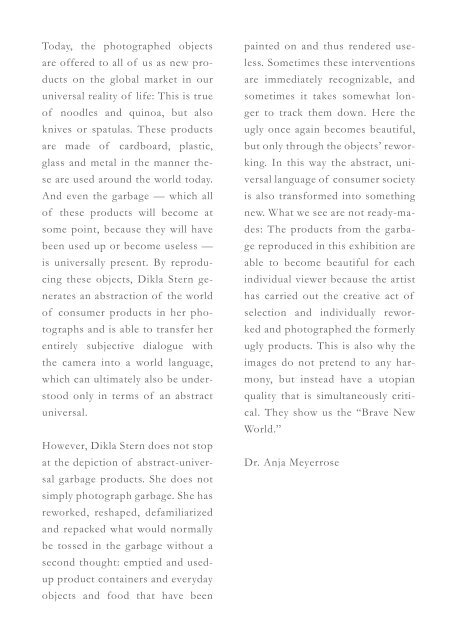STERN CONTEMPORARY Online Booklet
You also want an ePaper? Increase the reach of your titles
YUMPU automatically turns print PDFs into web optimized ePapers that Google loves.
Today, the photographed objects<br />
are offered to all of us as new products<br />
on the global market in our<br />
universal reality of life: This is true<br />
of noodles and quinoa, but also<br />
knives or spatulas. These products<br />
are made of cardboard, plastic,<br />
glass and metal in the manner these<br />
are used around the world today.<br />
And even the garbage — which all<br />
of these products will become at<br />
some point, because they will have<br />
been used up or become useless —<br />
is universally present. By reproducing<br />
these objects, Dikla Stern generates<br />
an abstraction of the world<br />
of consumer products in her photographs<br />
and is able to transfer her<br />
entirely subjective dialogue with<br />
the camera into a world language,<br />
which can ultimately also be understood<br />
only in terms of an abstract<br />
universal.<br />
However, Dikla Stern does not stop<br />
at the depiction of abstract-universal<br />
garbage products. She does not<br />
simply photograph garbage. She has<br />
reworked, reshaped, defamiliarized<br />
and repacked what would normally<br />
be tossed in the garbage without a<br />
second thought: emptied and usedup<br />
product containers and everyday<br />
objects and food that have been<br />
painted on and thus rendered useless.<br />
Sometimes these interventions<br />
are immediately recognizable, and<br />
sometimes it takes somewhat longer<br />
to track them down. Here the<br />
ugly once again becomes beautiful,<br />
but only through the objects’ reworking.<br />
In this way the abstract, universal<br />
language of consumer society<br />
is also transformed into something<br />
new. What we see are not ready-mades:<br />
The products from the garbage<br />
reproduced in this exhibition are<br />
able to become beautiful for each<br />
individual viewer because the artist<br />
has carried out the creative act of<br />
selection and individually reworked<br />
and photographed the formerly<br />
ugly products. This is also why the<br />
images do not pretend to any harmony,<br />
but instead have a utopian<br />
quality that is simultaneously critical.<br />
They show us the “Brave New<br />
World.”<br />
Dr. Anja Meyerrose


